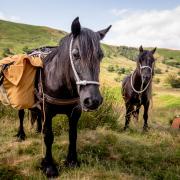Don’t ignore Lakeland’s lovely coastline, says professional photographer Mark Gilligan
While the Lake District has its obvious attributes for a photographer, don’t forget its coastline. It has some lovely dunes, beaches and this fabulous estuary at Eskmeals. Sunsets around here can be spectacular but I took this photograph early one afternoon - it’s a lovely place to visit.
Just to the side of Ravenglass, it is accessed by passing through the delightful little village of Waberthwaite. The narrow lanes open out to give you this fabulous vista. It is a tranquil haven.
As a keen ornithologist I try to make it one of my regular stops as it is possible to see many different waders, geese and peregrines on high and recently I watched as a red kite slowly passed overhead. It was a fantastic sight.
Those who come on my workshops know that I usually only take one lens out with me and this occasion was no different but I supplemented it with a polarising filter. The weather was glorious and knowing where I was going to walk meant I knew that filter would be all I needed.
I have stood on this little bridge many times, but this time I was struck by the cloud formations that had begun to ‘brew up’ as I looked back towards the Scafells and so I decided that the sky had to take precedence.
I could see the picture in my head and knew the wide-angle lens would really accentuate the shapes so they would dominate the image.
After a quick composition and a rotation of the filter to deepen the blue of the sky, the picture was ready to be taken. As it was a bright, sunny day with the light coming from behind me, I knew I would be able to comfortably hand-hold the image and so captured it before the fluffy shapes had disappeared.
I know the clouds are vital to the mood created in this image, but you still need to be pulled into it and the tributary provides a good way in. It is called a ‘lead in line’ as it takes you right into the Scafells and then the cloud shapes take the eye back up again.
The viewer literally looks at the whole frame. It’s a simple but effective technique. For me, the key is to stop and look for the natural shapes in the landscape and not to merely stand there and press the shutter.
Another factor to consider when taking clouds is the strength of the wind. Fortunately that day, its speed was very slow which gave me a little more time to wait for them to arrive at the correct point. You do have to act quickly when the shapes appear as more often than not, they will break up and you will lose the effect.
Usually, when I am out and about on a full shoot, I have my camera rucksack, accessories and tripod with me but there are occasions - like this one - when I will take either a smaller, mirrorless camera or literally strip the kit down and just take the ‘big one’ and one filter.
I keep it simple and it helps me to concentrate that little bit more. It improves your photography knowing that you have a very basic kit to hand.
Let’s get technical
Camera: Canon 5d mk3,
Lens: Canon EF17-40 L series
Settings: f/10@1/200th, ISO 100
Lee Polariser
You can find out more about Mark Gilligan and his photographic workshops at



























